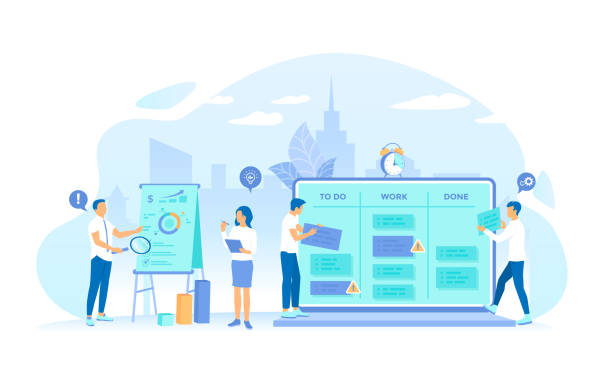The Importance and Necessity of Multilingual Website Design in Today’s World

In today’s interconnected and #globalized world, #businesses are increasingly looking to cross geographical borders and access #international_markets.
One of the most powerful tools for achieving this goal is multilingual website design.
Having a website only in Persian is no longer enough; to attract customers from all over the world, you must be able to communicate with them in their own language.
This approach not only helps increase customer #trust and #loyalty but also significantly improves your business’s accessibility and #visibility in global search engines.
Designing a website with support for multiple languages is not just a luxury option, but a strategic necessity for any business with global aspirations.
This section explains and analyzes this necessity, clarifying its various dimensions.
Expanding access to a global audience is the main advantage of a multilingual website.
When your website is available in multiple languages, you can reach audiences that were previously inaccessible due to language barriers.
This directly impacts your website traffic and, ultimately, your conversion rate.
For example, if you offer a product or service with significant market potential in Europe or Asia, you will miss a substantial portion of this market without a multilingual website.
Furthermore, a multilingual site enhances your business’s credibility and professionalism at an international level.
International customers seek platforms that understand their needs and speak their language, and this sense of trust naturally leads to increased engagement and sales.
Search engines like Google value multilingual websites for providing relevant content to users in different regions.
By correctly implementing International SEO techniques, you can ensure that each language version of your site ranks well for its target audience in search engines.
This includes using hreflang tags, appropriate URL structure, and accurate keyword translation.
Ignoring these aspects can lead to missing countless opportunities in foreign markets.
Therefore, if you are looking for sustainable growth and competition in the global arena, investing in multilingual website design is no longer a choice but a necessary step towards the future.
Are you losing potential customers due to an unprofessional website? Rasaweb is your answer! With our specialized corporate website design services:
✅ Enhance your business’s credibility and standing
✅ Experience attracting more targeted customers
⚡ Act now for a free consultation!
Strategic Planning for Multilingual Website Design

Before any practical action for #creating a multilingual #website, having a detailed and #strategic #planning is crucial.
This stage includes identifying #goals, #target_audience, and necessary #resources.
Comprehensive planning helps you prevent waste of time and money and carry out the multilingual website design process in the best possible way.
This section offers guidance and educational insights to help you navigate the initial steps correctly.
The first step is to define your objectives for making your website multilingual.
Are you looking to increase sales in a specific region? Do you intend to increase your brand awareness globally? Or do you want to make your educational content accessible to a broader audience? The answers to these questions will determine which languages should be added to the website.
After that, you need to carefully identify your target audience for each language.
Simply translating words is not enough; you must pay attention to the culture, local idioms, and even visual preferences of your audience in each geographical region.
For example, colors, images, and even the layout of elements on the site may have different meanings in different cultures.
Understanding these subtle differences is a key element in designing a successful user experience for international audiences.
Choosing the right languages is also of paramount importance.
Reviewing current website traffic statistics (if there is an international audience), competitor analysis, and market research can assist you in this regard.
Is a significant portion of your non-Persian traffic from German-speaking countries? Then German should be a priority.
Does your product have high potential in South America? Don’t forget Spanish.
Also, you need to estimate the #resources required for multilingual website development; this includes the budget for translation, hiring expert developers, and site maintenance.
Strong and meticulous planning not only helps you see the path clearly but also ensures that your investment ultimately leads to desired results and your multilingual website design project is successfully completed.
Technical Structure and Platform Selection for Multilingual Websites

Choosing the right #technical_structure and #platform forms the backbone of any successful multilingual #website.
These decisions directly impact site #performance, #SEO, and the #ease_of_management of content.
From #URL_structures to #Content_Management_System (CMS) selection, every component must be chosen carefully to provide a smooth and optimized user experience for global audiences.
This section delves into technical details in a specialized and educational manner.
One of the most important technical decisions is how to organize URLs for different languages.
There are three main approaches:
| Structure Type | Example | Advantages | Disadvantages |
|---|---|---|---|
| Subdomain | en.yourdomain.com |
Easy separation, possibility of separate hosting | Requires separate SEO management, less understood as a language |
| Subdirectory | yourdomain.com/en/ |
Google-preferred, central SEO, easier management | Requires unified hosting, slightly more complex in initial organization |
| Country Code Top-Level Domain (ccTLD) | yourdomain.de |
Best option for local SEO, high trust | Most expensive, requires managing multiple domains, necessitates purchasing new domains |
Each of these structures has its own advantages and disadvantages, and their selection depends on your SEO goals and budget.
Additionally, the correct use of hreflang tags in the site’s HTML code is essential to inform search engines about different language versions of each page.
These tags help Google show the correct version of the page to users based on their language and geographical location.
Choosing a Content Management System (CMS) is also a crucial step in multilingual website design.
Many popular CMSs like WordPress (using plugins like WPML or Polylang), Drupal, or Joomla, offer multilingual capabilities.
Some CMSs support this capability natively, while others require plugins or custom development.
It is important that your chosen CMS provides easy content management in different languages, regular updates, and strong support.
This choice should be made considering the site’s complexity, content volume, and your team’s expertise.
A powerful and flexible platform helps you complete the multilingual website creation process with minimal challenges and easily expand it in the future.
Content Translation and Localization Beyond Words

#Translation of content for a multilingual #site goes far beyond simply replacing words with their equivalents in another language.
This process involves complete #localization of content, meaning that not only the text, but also #concepts, #idioms, and even #jokes must be aligned with the culture and preferences of the target audience in that specific language.
Ignoring this aspect can lead to cultural misunderstandings, reduced user trust, and even damage to your brand.
This section focuses on the importance of localization in an educational and specialized manner.
In multilingual website design, translation quality is paramount.
Using native speakers who, in addition to full language proficiency, are familiar with the culture and market where the content will be presented, is crucial.
These individuals can ensure that your message is conveyed correctly and that no ambiguity or misunderstanding arises.
For example, a common idiom in Persian might be completely meaningless or even offensive in English.
Localization includes adapting units of measurement (e.g., converting centimeters to inches), date and time formats, phone numbers, currency, and even colors and images, which may have different meanings in various cultures.
This attention to detail is what transforms a multilingual website from merely “translated” to “localized” and thus more effective.
Furthermore, it should be noted that localization is not limited to textual content.
Images, videos, and graphical elements must also be culturally appropriate for the target audience.
For example, an image that is perfectly normal in one culture might be considered inappropriate in another.
The choice of tone and writing style is also very important.
Are your audiences formal or informal? Is an advertising tone acceptable, or should it be more informative? These decisions should be based on market research and a precise understanding of the audience for each language.
Investing in professional localization ultimately leads to increased engagement, improved user experience, and higher conversion rates, and is an integral part of a successful multilingual website design project.
Does your current corporate website adequately represent your brand’s image and attract new customers?
If not, let Rasaweb solve this challenge for you with our professional corporate website design services.
✅ Significantly boost your brand’s credibility and image.
✅ Pave the way for attracting new leads and customers.
⚡ Click now for a free and specialized consultation!
Search Engine Optimization (SEO) for Multilingual Websites

#International_SEO is one of the most complex yet crucial aspects of #multilingual_website_design.
Without proper #optimization for search engines in each language, even the best translations may never reach the #target_audience.
This process includes keyword research for each language, correct use of hreflang tags, and management of internal and external links.
This section addresses the principles of international SEO in a specialized and guidance-oriented manner.
The first step in SEO for a multilingual website is to conduct keyword research for each language.
Keywords that are successful in one language will not necessarily be effective in another.
Direct translation of keywords often leads to poor results.
Instead, local keyword research tools should be used to identify phrases that native speakers of each language actually search for.
This includes understanding cultural differences in how information and products are searched.
For example, a word common in English might be a technical or even obsolete word in Spanish.
After identifying appropriate keywords, they should be naturally incorporated into the site’s content, page titles, meta descriptions, and URLs.
The use of hreflang tags, as mentioned in previous sections, is essential for informing search engines about different language versions of a page.
These tags help Google prevent duplicate content and display the appropriate version of the page to the user based on their language and geographical location.
In addition to hreflang, technical optimization such as site loading speed, mobile compatibility, and a logical internal linking structure are also important in international SEO.
The internal linking structure should allow users and search engine crawlers to easily navigate between different language versions.
These technical measures, along with the production of high-quality, localized content, help your building a global platform achieve higher rankings in its target markets and attract more organic traffic.
User Experience (UX) and User Interface (UI) in Multilingual Websites

#User_Experience (UX) and #User_Interface (UI) are the main pillars of success for any #website, but their importance doubles in the case of multilingual website design.
A poor user experience can quickly drive users away from your site, even if your content is excellent.
Designing UI and UX for international audiences requires attention to cultural differences, language preferences, and various behavioral patterns.
This section addresses these vital aspects in a guidance and educational manner.
One of the most important elements in the UX of a multilingual site is the ease of changing language.
The language switcher button or menu should be clearly visible, preferably in the site’s header, and use standard icons like flags or language names.
Keep in mind that using flags might be sensitive in some cases, as a single language may be spoken by multiple countries (e.g., Spanish in Spain and Latin America).
Therefore, using the language name (e.g., “English”, “Deutsch”, “العربية”) alongside a global icon like a globe, is a safer option.
Furthermore, the user interface design must be adaptable to different text lengths in various languages.
A button or title that fits well in English might become too long in German or Persian, causing visual clutter.
Therefore, the design must be flexible to display texts correctly in different languages.
Responsive design and accessibility across various devices are also essential for international users, as they may use different devices and internet speeds.
Finally, attention to text direction (e.g., right-to-left for Persian and Arabic, and left-to-right for English and most languages) and cultural reviews of visual elements helps create a multilingual platform that is not only functional but also appealing and familiar to every user, anywhere in the world.
Common Challenges and Solutions in Multilingual Website Design

Despite its numerous advantages, #multilingual_website_design also comes with several #challenges, ignoring which can lead to project failure.
From issues related to #translation_quality to #technical and #management problems, every step requires precision and planning.
Understanding these challenges and finding effective #solutions for them is the key to success in a multilingual website design project.
This section addresses these obstacles and solutions through thought-provoking content and analytical insights.
One of the most common challenges is ensuring the quality and accuracy of translation.
Machine translation is often insufficient and can lead to glaring errors or miscommunication.
The solution is to use professional native translators who specialize in your business domain.
Also, creating a glossary of industry-specific and brand-specific terms can help maintain consistency and accuracy of translations over time.
Another challenge is multilingual content management.
As the number of languages increases, managing updates, edits, and content publication can become complex.
Using a powerful Content Management System (CMS) with native multilingual capabilities or robust plugins like WPML for WordPress can simplify this process.
Technical issues are also a significant part of the challenges.
Choosing the appropriate URL structure (subdomain, subdirectory, or ccTLD) and correctly implementing hreflang tags for SEO requires technical expertise.
Common errors in this area can lead to SEO penalties or your pages not being visible in search engines.
Finally, budget and time are also determining factors.
Creating a multilingual website requires a significant investment in translation, development, and maintenance.
In the table below, you can see some common challenges and their solutions:
| Challenge | Explanation | Solution |
|---|---|---|
| Low translation quality | Using machine translation or unprofessional translators leading to misunderstandings. | Hiring specialized native translators, creating a brand glossary. |
| Complex content management | Difficulty in updating and maintaining content in multiple languages simultaneously. | Choosing a suitable CMS with strong multilingual capabilities (e.g., WPML, Polylang). |
| International SEO issues | Incorrect ranking in search engines due to improper hreflang implementation or URL structure. | Consulting with an international SEO specialist, precise implementation of hreflang tags and URL structure. |
| Cultural considerations | Ignoring cultural differences in design, images, and tone. | In-depth cultural research, using local designers and localizers. |
With careful planning and attention to detail, these challenges can be turned into opportunities to build a powerful and effective multilingual site.
Useful Tools and Platforms for Multilingual Website Design

Choosing the right #tools and #platforms plays a significant role in the ease and efficiency of the #multilingual_website_design process.
From Content Management Systems (CMS) to translation plugins and localization services, every tool can help you in the #development and #management of a successful multilingual #website.
This section introduces some of these tools in an educational and informative manner.
At the heart of every multilingual website design is a Content Management System (CMS).
WordPress is one of the most popular CMSs that easily gains multilingual capabilities with plugins like WPML (WordPress Multilingual Plugin) or Polylang.
WPML is a comprehensive plugin that allows the translation of posts, pages, categories, tags, and even themes and plugins.
Polylang is a lighter alternative suitable for smaller projects.
In addition to WordPress, other CMSs like Drupal and Joomla also leverage native multilingual features or powerful extensions for this purpose.
For managing the translation process, Translation Management Systems (TMS) such as MemoQ, Trados, and Smartling can be very useful.
These platforms allow you to centrally manage website content, assign translation processes to different teams, and even use Translation Memories and glossaries to maintain consistency and reduce costs.
Also, for multilingual website development and ensuring its correct functioning in different browsers and for users worldwide, testing and debugging tools like Google Search Console for checking international SEO status and site speed testing tools like PageSpeed Insights for performance optimization are essential.
Using the right set of tools can significantly increase the efficiency and effectiveness of creating a global platform.
Does your current corporate website not adequately reflect your brand’s credibility and power? Rasaweb solves this challenge for you with professional corporate website design services.
✅ Increase credibility and visitor trust
✅ Attract more targeted customers
⚡ Click now for a free consultation!
Measuring Success and Data Analysis in Multilingual Websites

After launching a multilingual #site, the next critical step is #measuring success and #data_analysis.
Without sufficient #insight into site performance across different languages and regions, you cannot optimize your #strategies or accurately assess your return on investment.
Web analytics tools like Google Analytics play a key role in this process.
This section addresses this topic in an analytical and guidance-oriented manner.
To accurately analyze the performance of your multilingual website, you need to segment data by language and geographical location.
Google Analytics allows you to view inbound traffic, bounce rate, time on site, and conversion rate based on the user’s browser language or geographical location.
This information helps you understand which language versions perform better and which regions show more interest in your content.
For example, if you observe that the Spanish version of your site has high traffic but a low conversion rate, it might indicate that the content needs more localization or a call-to-action adjustment.
In addition to traffic and conversion metrics, monitoring keywords and SEO rankings in each language is also highly important.
Using SEO tools to track keyword rankings in local search engines can help you identify the strengths and weaknesses of your international SEO strategy.
Direct feedback from users is also invaluable.
Adding feedback forms or small surveys in different language versions can provide deep insights into user experience and local audience needs.
By continuously collecting and analyzing this data, you can constantly improve your multilingual website design, optimize your content, and ultimately achieve your global business goals.
This data-driven approach is key to sustained success in multilingual website development.
Thought-Provoking Content on Multilingual Sites: Attracting a Global Audience

For true success in the #global_market, simply translating content is not enough; you must produce content that #challenges, #curious, and makes #audience #think.
#Thought_Provoking_Content on multilingual #sites can be a powerful tool for #attracting and #retaining an audience, beyond mere information.
But how can content be created that is thought-provoking and engaging across different cultures? This section addresses this topic through thought-provoking content and analytical insights.
Thought-provoking content usually deals with topics that have global dimensions but are approached from local perspectives.
For example, an article about the future of artificial intelligence can be interesting to audiences worldwide, but its impact on local job markets or its ethical aspects might differ across cultures.
For multilingual website design with thought-provoking content, you first need to identify the general topics of interest to your target audience.
Then, using local insights, address different dimensions of these topics.
This might include comparing cultural viewpoints, presenting local statistics, or even asking challenging questions whose answers vary in different cultures.
The goal of thought-provoking content is to create dialogue and engagement.
This type of content encourages users to share their opinions, participate in discussions, and spend more time on your site.
For this purpose, you can use formats such as in-depth analytical articles, podcasts, short documentary videos, or even intellectual contests and challenges.
Ensure that the translation of this type of content is equally accurate and localized to preserve its original meaning and thought-provoking tone.
A multilingual platform that offers rich and intellectual content will be recognized not only as an informational resource but also as a thought leader in its field, which in turn helps increase your brand’s credibility and loyalty globally.
Frequently Asked Questions
| Question | Answer |
|---|---|
| 1. What is multilingual website design? | The process of creating a website whose content is available in several different languages so that users from all over the world can interact with the site in their own language. |
| 2. Why should we make our site multilingual? | To expand the market, attract international audiences, improve SEO in global search results, and increase brand credibility and professionalism. |
| 3. What are the methods for implementing a multilingual site? | Using subdomains (e.g., fa.example.com), subdirectories (e.g., example.com/fa/), URL parameters (e.g., example.com?lang=fa), or country-code domains (e.g., .ir, .de). |
| 4. Is multilingual site SEO different? | Yes, it requires international SEO strategies such as using hreflang tags, appropriate URL structure for each language, and keyword research for each language. |
| 5. What points should be considered when choosing languages? | Languages should be chosen based on the target market, audience demographics, and current website traffic analysis data. |
| 6. What are the common problems in multilingual site design? | Problems related to SEO, translation quality, content management, right-to-left (RTL) and left-to-right (LTR) support, and user experience. |
| 7. What is the role of CMS in multilingual sites? | Modern Content Management Systems (CMS) (such as WordPress with multilingual plugins or Drupal) provide built-in features or powerful plugins for easy content management in multiple languages. |
| 8. How should content translation be done? | Translation should be done by professional native translators, not just machine translation, to ensure cultural nuances, tone, and local idioms are respected. |
| 9. How is language switching done on multilingual sites? | A Language Switcher is usually used in the header or footer of the site, allowing users to easily select their desired language. |
| 10. Is responsive design important for a multilingual site? | Yes, responsive design ensures that the site is displayed correctly on any device (mobile, tablet, desktop), which is vital for international user accessibility and SEO. |
And other advertising services of Rasaweb Advertising Agency in the field of advertising
Smart Digital Advertising: A novel service to increase website traffic through SEO-driven content strategy.
Smart Custom Software: Transform campaign management with intelligent data analysis.
Smart Marketing Automation: A novel service to enhance customer behavior analysis through attractive UI design.
Smart Advertorial: A blend of creativity and technology for customer behavior analysis through user experience customization.
Smart Digital Advertising: An effective tool for campaign management with key page optimization.
And over hundreds of other services in internet advertising, advertising consulting, and organizational solutions
Internet Advertising | Advertising Strategy | Advertorial
Resources
Search Engine Optimization for Multilingual Websites
Digital Marketing Strategies for Global Success
The Importance of Web Design for International Audiences
Benefits of Website Localization in Attracting Foreign Customers
? For your business to grow and shine in the online space, Rasaweb Afarin Digital Marketing Agency is by your side, offering the best services. To enhance your digital presence and learn more about our solutions, including our professional personal website design services, visit us.
📍 Tehran, Mirdamad Street, next to Bank Markazi, Kazeroun Jonoubi Alley, Ramin Alley, No. 6

